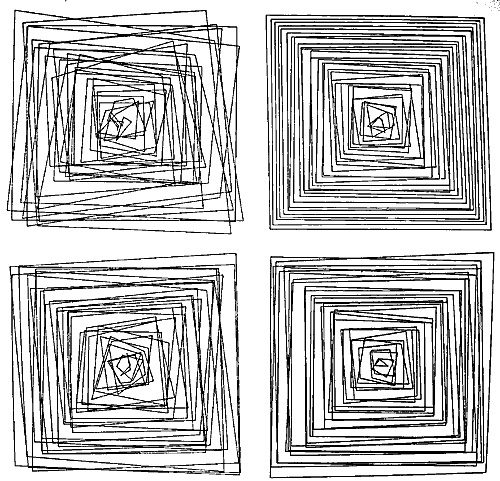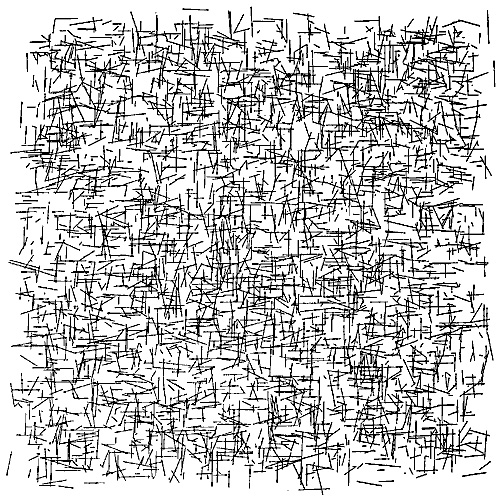Chapter 9: Computer Artists
9.2 Vera Molnar
 Vera Molnar was born in 1924 in Budapest, Hungary. After studying at the Budapest Academy, she received her diploma in 1947 in Art History and Aesthetics. Her artwork has always been focused on abstract and geometrical paintings. That same year, she received the Rome Scholarship and moved to Paris.
Vera Molnar was born in 1924 in Budapest, Hungary. After studying at the Budapest Academy, she received her diploma in 1947 in Art History and Aesthetics. Her artwork has always been focused on abstract and geometrical paintings. That same year, she received the Rome Scholarship and moved to Paris.
In 1960, Molnar co-founded the “Groupe de recherche d’art visuel” , or GRAV (GRAV was founded in July 1960 by Vera Molnar, François Morellet, Horacio Garcia Rossi, Julio Le Parc, Francisco Sobrino, Joël Stein, and Jean-Pierre Yvaral).This group was a proponent of stripping the content away from the visual image in their medium in order to focus on seeing and perceiving. They were instrumental in the Op-art and Kinetic Art movements of that decade. Molnar was also co-founder of the group “Art et Informatique” at the “Institut d’Esthetique et des Sciences de l’Art” in Paris in 1967.
According to Molnar, in her eyes her work has a hypothetical character. In order to systematically process her research series, she invented a “technology”, which she called “Machine Imaginaire”. She sketched a program, and then, step by step, realized a simple, limited series, which was self-contained.
In 1968 she discovered the power of the computer to allow an artist to step away from “the social thing” in order to get at the real creative vision. She replaced the illusory computer, the invented machine, by a genuine computer. Her initial work involved transformations of geometric objects, such as a square, by rotating, deforming, erasing all or parts of them, or replacing portions with basic elements of other geometric shapes. She would often repeat the geometric primitives while fracturing or breaking them as she transformed them, ultimately outputting them to a plotter.
Molnar did work at the Centre Pompidou, ARTA (Atelier du Recherche des Techniques Avancees) and was a member of the CREIAV (Centre de Recherche Experimentale et Informatique des Arts Visuels). In 1985 she became a Professor at the University of Paris, Sorbonne.
“Proceeding by small steps, the painter is in a position to delicately pinpoint the image of dreams. Without the aid of a computer, it would not possible to materialize quite so faithfully an image that previously existed only in the artist’s mind. This may sound paradoxical, but the machine, which is thought to be cold and inhuman, can help to realize what is most subjective, unattainable, and profound in a human being.”
From Frank Popper’s Visualization, Cultural Mediation and Dual Creativity in Leonardo.


